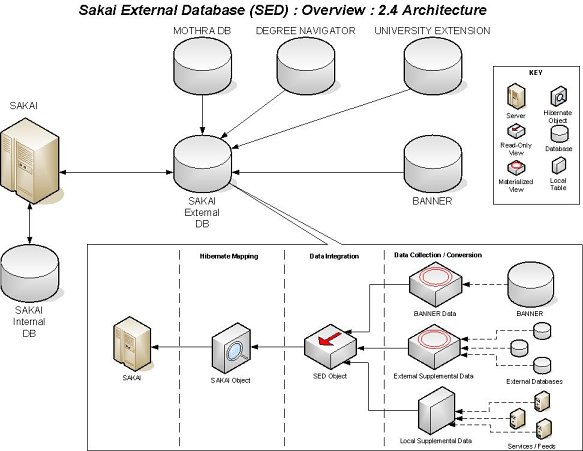Sakai External Database
Sakai External Database
The Sakai External Database acts as the central source of most, if not all, data external to Sakai. This data is collected from various campus systems, primarily in the form of database tables and queries. The collected data is then transformed into a single source of data presented in a format amenable to the Sakai provider mechanisms.
Requirements
- Data Sourcing: Data being provided to the External Database can come from a number of different campus systems. The database must be able to handle loading data from linked databases, extract procedures, and other systems. In some cases, the external database will locally store and manage data sources.
- Data Refresh: Each source of external data will carry with it a refresh requirement. These refresh requirements may include near-realtime, timed, or ad-hoc scenarios. The external database must be able to fulfil the refresh requirements for each data source.
- System Response: Given that the repository generally aggregates data from external sources, the speed by which aggregated data is provided to Sakai must be optimized.
- Data Synthesis: In some cases, multiple data sources may contain similar versions of source data. Care must be taken when synthesizing this data for presentation to Sakai.
- Data Availability: Sakai will be a core campus system, and therefore should exhibit maximum availability of data. This availablity requirement extends to the data dependence on source systems. If the source system does not provide a sufficient degree of availability, measures must be taken to ensure the data is avaiable when the source system is offline.
Architectural Design
The External Database will be hosted on a single database server. This database will, at one end, allow data to be fed into it from various source systems on campus, and at the other end will provide a database schema readable by Sakai, and formatted to be as efficient as possible in the Sakai structure.
Data will be processed and provided to Sakai via three layers:
- Data Collection and Conversion: The data to be used in the external database will be collected from the various source systems. Data can be collected in the form of:
- Oracle Materialized Views
- Direct Database-Linked Views
- Procedural Feeds into Local Tables
- Locally Managed Tables
The data will be converted into a format amenable to Sakai during the collection process. This eliminates the need for a later conversion stage and provides performance benefits.
- Data Integration: The collected data is coalesced into homogenous data views. These views are resposible for converting data to ensure that type and key values are consistent.
Data Sources
The enterprise database will collect and aggregate data from:
- BANNER
BANNER is the student information system (SIS) at UC Davis. It is sthe system of record for most information on students, courses, instructors, and enrollment. The majority of data consumed by Sakai will come from this system. - Degree Navigator
While BANNER does contain a course description, it is not the system of record for course descriptions. The Course Approval Form database is the course description system of record and must be consulted when loading course descriptions. We do not have direct access to the CAF database. We do have access to the Degree Navigator database, which is periodically updated with data from CAF. - University Extension
Through a process known as Open Enrollment, University Extension students may participate in University courses. However, those students are not recorded in Banner. Sakai will retrieve Open Enrollments from the University Extension database and add those enrollments to the Banner list of enrolled students. - MOTHRA
Mothra is the UC Davis system of record for unique person identification. It stores a unique identifier for each member of the campus community, along with any other identifiers that exist in other campus systems. Banner, University Extension, and Sakai all use different identifers to reference users. Therefore, Mothra data is necessary to match identity among the disparate sources.
Data Usage
The data collected by the External Database will be used primarily by two Sakai services: Course Management Service and User Directory Provider. The design and implementation of those services are hosted in other parts of this wiki:
